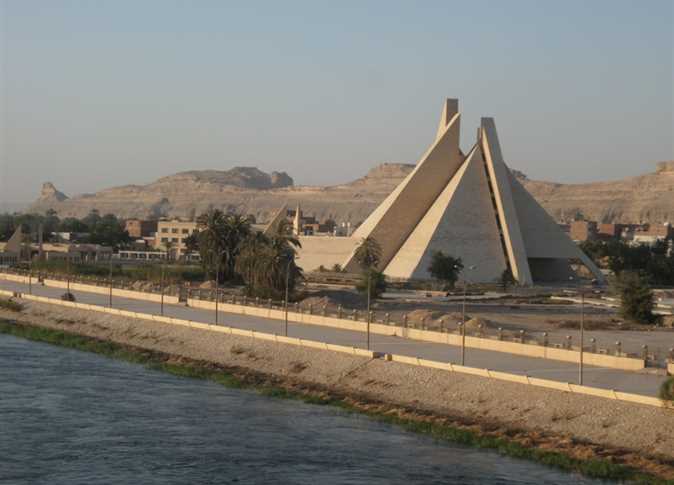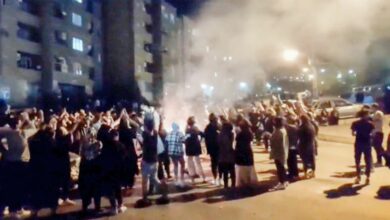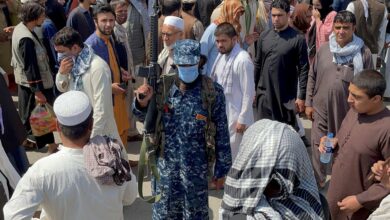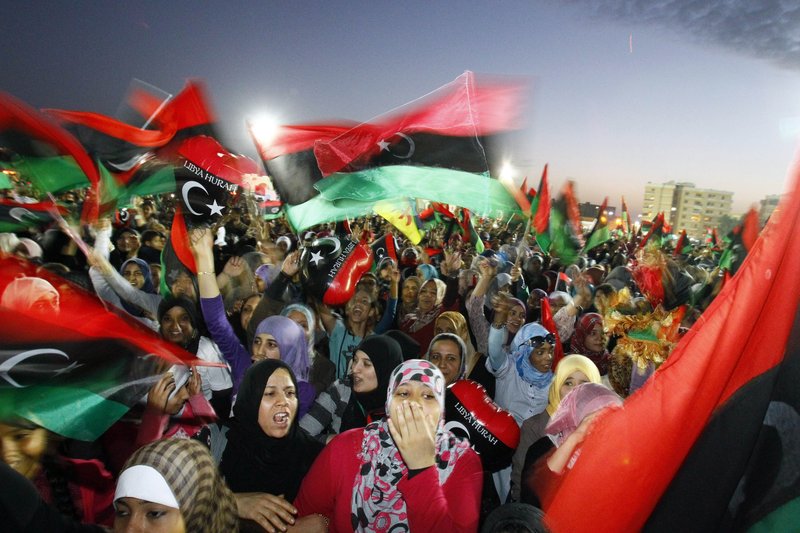On 16 January, two days after Tunisia’s Zine El Abidine Ben Ali resigned, Mohamed Tawfik drew a simple cartoon. In it, a solitary, average-looking man pauses while walking through an urban scene to look up at the sky, where a large five-pointed star appears next to a crescent–the shape of the Tunisian flag. “The moon looks very lovely tonight!” he says. Published when most people didn’t dare dream that anything similar could happen in Egypt, it’s perhaps even more touching in retrospect.
Tawfik’s 26 January drawing, “The Arab Tree,” shows a dead black and white tree with one bright red apple bearing the same star and crescent; on 12 February, the day after Hosni Mubarak resigned, Tawfik updated the image with the Egyptian flag. It contains a subtle invitation: If you want to live, you must demand change.
The 25 January revolution was a productive period for Egyptian cartoonists. Some produced work daily, from the Tunisian revolution through the mass demonstrations here, to the post-revolutionary developments and unrest in other Arab countries.
“Cartoons are powerful because they help you decide how you feel about what’s happening. If I couldn’t read a newspaper for a day, I could see just one cartoon and feel informed about what people were thinking,” said artist Asmaa Youssef.
Many cartoons appeared in newspapers and on the streets during the demonstrations, and an archive can be found on Facebook. A medium that particularly revels in freedom of speech would be unlikely to feature much support for the toppled president Mubarak, who tried through a variety of means to eradicate his critics. So it’s not surprising to find that almost all cartoonists were on the side of the revolutionaries.
There are exceptions. Cartoons in state-owned daily Al-Akhbar by 76-year-old Mostafa Hussein, head of the Egyptian Association for Caricature and former president of the artists’ union, reflect a pro-Mubarak stance. One, published after Mubarak’s first speech during the revolution, shows a yellow sun with “Mubarak’s speech” written on it, scaring a bunch of black demons into the corner of the frame.
A good cartoon tends not to be propagandist but questioning, whoever the author supports. But during a revolution, taking sides can be necessary and feelings run high. Cartoons can try to spur people to action; for example, many cartoonists encouraged people to go and vote in the March constitutional referendum.
Tawfik sees his current task as working against the divisions that arose after the referendum, encouraging people to calm down and not be seduced by sectarian thinking. His work’s biggest strength is it simplicity — its obviousness is the very reason for its poignancy — and he was prolific during the revolution.
“Conditions changed — every day now there are new events and news that must be tackled,” he said, pointing out what a unique opportunity the revolution presents for caricaturists.
Another drawing of his from early February shows a large veiled woman with “Egypt” written on her flowing abaya stopping a black cab and saying, “Tahrir, my son!?” Both woman and driver look happy, and the drawing could not have been better timed: when state media had managed to convince people that Cairo’s Tahrir Square — the epicenter of the revolution’s pro-democracy protests–was full of foreign-funded spies, the cartoon suggests something different. The most traditional, stereotypical version of Egypt herself asked to be inside the square: Tawfik seems to be saying that the square became all of Egypt — Tahrir was where Egypt was. At the same time, the drawing was an invitation to Egyptians to go and ask for their rights.
A March cartoon by Walid Tahir, which has a taxi driver saying to himself, “Since the day before yesterday everyone alights at New Cairo!” shares the same celebratory sense of wonder.
In another drawing, Tahir, whose approach is often loose and experimental, has a surrealist take on what the remnants of the formerly-ruling National Democratic Party look like. A dollar sign and a police helmet can be made out among shapeless blobs.
Some cartoons played on the slogans shouted during the protests, many of which already involved wordplay. “Raise your head high, you’re Egyptian!” went one, and a recent irreverent drawing from Tawfik shows two unusually long-necked men talking to each other: “It's funny, my head has felt very high since 25 January.” “Mine too,” says the other one.
Other artists needed time to digest events. Hicham Rahmah recently posted in bulk a series of slickly designed revolution-related cartoons. One shows an unarmed youth climbing out of a computer in front of a terrified police officer in full riot gear, holding his shield and baton.
This week, the second issue of the Egyptian comic book magazine "Tok Tok" launches. It is well timed to incorporate revolutionary material, and indeed its patriotic but pop philosophy seems to reflect the spirit of many of the young revolutionaries.
And as the work of the revolution is not yet secured, the work of the cartoonists isn’t over. The dark skepticism of Doaa Eladl’s roughly-drawn work — strengthened by strange facial expressions — highlights this. Though in her twenties, Eladl, who works for Al-Masry Al-Youm, is the most prominent female cartoonist in Egypt and has also been very prolific as events unfolded.
Her recent drawing, “The new law banning protests,” shows a car facing up a slope while behind it a cliff drops away. Written on the car is “25 January” — it is difficult to tell if it is moving forward or sliding backwards, but it is blaring the warning of a vehicle in reverse.




